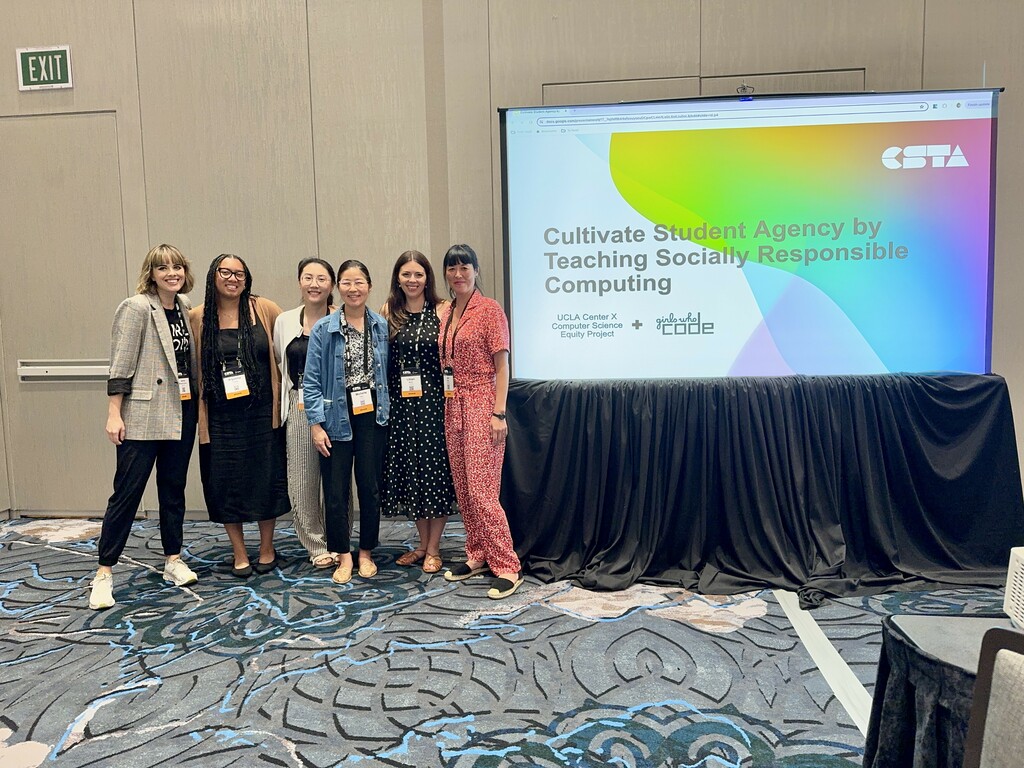
With a rich background in research, communications, and education technology, UCLA Center X Associate Director and CSforCA member Michelle Choi brings a unique perspective to her work. As a mother of two young daughters, she is personally invested in ensuring that all children have access to high-quality public education and the opportunities that come with learning computer science. Read Michelle’s spotlight to learn about her journey, her insights on integrating technology into education, and the experiences that have informed her passion for CS equity.
I was born in Canada, grew up in Florida, and eventually moved to California. I attended UC San Diego, where I studied French literature and minored in Biology and Psychology. My interest in education was always strong, but I wasn't sure if I wanted to become a classroom teacher. After graduating, I worked at Otis College of Art and Design, where I got involved in a documentary project that helped me see the connections between education, media, and technology. This led me to the Harvard Graduate School of Education, where I pursued a Master's in Technology, Innovation, and Education. During this time, I interned with the ScratchEd team at MIT Media Lab, which solidified my passion for using technology for creative learning. I managed the ScratchEd online community and helped develop the Creative Computing Curriculum. After 5 years, I moved back to California and worked at the Exploratorium in San Francisco, managing research-practice partnerships between museum researchers, university faculty, afterschool educators, and K-12 teachers across the US. Eventually, I relocated to Los Angeles to be closer to family. Here, I connected with CSforCA leaders and joined the UCLA Center X team where I’m excited to continue work focusing on broadening participation in technology and using it for creative learning purposes.
Integrating computer science and educational technology into existing curriculum promotes high-quality public education for all students. CS integration allows for experimentation, while also highlighting existing inequities such as lack of access to hardware, internet, and resources. One effective way to integrate CS into current educational programs is to see technology as a means for demonstrating learning through creative outputs. For example, educators can combine existing projects with technology—using tools like Scratch to animate book reports, create digital art projects, or conduct art history presentations. This approach gives students new tools for creative expression, extending the learning without taking away from core curriculum. It also helps to introduce technology in a low-stakes manner, making it accessible to more students—especially those who may not traditionally engage with technology or coding. These integration methods are supported by initiatives like CSforCA, which aims to integrate CS into core standards and curricula and ensure all students have rich, high-quality experiences with technology throughout their K-12 education. To that end, I helped design and develop the CS Equity Guide for educational leaders to create and sustain equitably-minded K-12 CS programs.

Overall, having kids has underscored the urgency I feel about advocating for equitable computer science education. I want my daughters—and all children—to have access to meaningful technology experiences, not just as consumers but as creators.
As a parent and professional, I’ve tried to do my part to incorporate equitable CS education at home and beyond. I've introduced my daughters to computer science activities for elementary students as well as hands-on tools like Scratch and littleBits. This personal journey has reinforced my commitment to my own work in CS equity—working with partners who prioritize equity like Girls Who Code and promoting a graphic novel about the good and bad of tech. At work, I was also a key part of developing the How Does Your Garden Grow? Parent Engagement Action Brief, to help parents introduce computational thinking and other CS concepts to their young children. My work and advocacy aim to create a more equitable educational landscape, ensuring all children have the opportunity to explore and understand technology.
At Center X, I get to amplify the incredible efforts being made in the field of CS education and make research accessible to a broader audience. Growing up, I loved documentaries and the idea of using media to share perspectives and communicate effectively. This passion has carried over into my professional life.
One of the key roles I play at Center X is translating complex research into practical formats. For example, I take research papers produced by our team that may be filled with pages of data or jargon and distill them into tweets, practical tips, or practice briefs that educators can quickly and easily use in their classrooms. Given that teachers often have little time and support to integrate computing into their lessons, making this information accessible and user-friendly is crucial.
Many teachers are new to technology themselves, so what I find most fulfilling is knowing that my efforts help educators feel more supported and equipped to bring computer science into their classrooms. By helping to bridge the gap between research and practice, I feel I’m contributing to a larger goal of equitable and high-quality education for all.
I would tell hesitant parents, educators, and other community members that computing is just another tool for the toolbox. It’s something useful and valuable to learn, much like any skill. In fact, addressing the comfort and confidence of educators and facilitators with computing has been a relevant part of my work. This challenge often arises: we developed all these great tools and resources, and now how can we help people to feel comfortable enough to use them? In this way, my work combining research and communications helps to spread awareness of the importance of CS education and disseminate research into practical application. I’m thankful that my role with Center X and CSforCA can help bridge these gaps, and I’m excited to continue advocating for equitable CS alongside my colleagues.